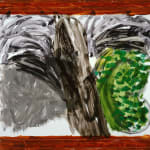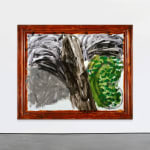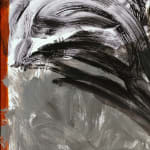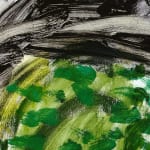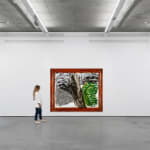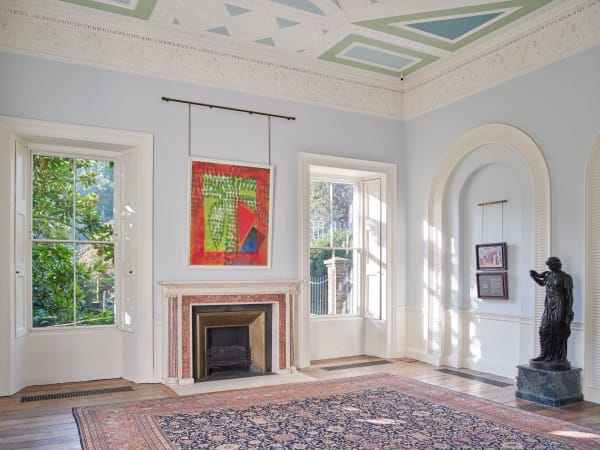Howard Hodgkin 1932, London, UK-2017, London, UK
-
 Photograph: Sarah Lee/The Guardian
Photograph: Sarah Lee/The Guardian -
Howard Hodgkin is widely regarded as one of the most important painters of his generation and occupied a central position in contemporary art for over half a century.
DOWNLOAD CV >
Born in London in 1932, Hodgkin spent part of his childhood on Long Island, New York, during World War II. There he first encountered the work of Henri Matisse, Édouard Vuillard, Pierre Bonnard, and Pablo Picasso — artists whose treatment of color and emotion profoundly shaped his early sensibility. After returning to England, he studied at the Camberwell School of Arts and Crafts (1949–50) and the Bath Academy of Art in Corsham (1950–54).
Independent throughout his career, Hodgkin never aligned himself with any school or movement. By the late 1950s, he had established the key subjects that would remain central to his art — personal memories, specific places, and moments of human connection. His work translated recollection into color, form, and rhythm, evoking the emotional resonance of lived experience. The vivid palette and painterly energy of his early representational works reveal the influence of Max Beckmann and Emil Nolde. His lifelong engagement with India — a country he visited regularly throughout his life — is reflected in his luminous palette and rhythmic compositions, and remains one of the most distinctive aspects of his legacy.
In 1962, at the age of thirty, Hodgkin held his first solo exhibition at Arthur Tooth and Sons in London. His first retrospective, curated by Nicholas Serota, was presented at the Museum of Modern Art, Oxford, in 1976. The 1980s brought him international recognition: representing Britain at the 41st Venice Biennale in 1984 and winning the Turner Prize in 1985 established his reputation as one of the leading figures in contemporary British painting.During the 1970s, Hodgkin developed a distinctive approach that became his hallmark — painting on wooden panels rather than canvas, often incorporating the frame as an active pictorial element. While the works of the 1980s retained traces of recognizable imagery — figures, interiors, landscapes, or still lifes — his later paintings moved toward greater abstraction, composed of layered gestures and chromatic intensity. “I paint representational pictures of emotional situations,” he once said, encapsulating his fusion of feeling and structure.
He was knighted in 1992, awarded the Shakespeare Prize by the Alfred Toepfer Foundation (Hamburg) in 1997, made a Companion of Honour in 2003, and received the Swarovski Whitechapel Gallery Art Icon Award in 2014.
Howard Hodgkin’s paintings and prints have been the subject of major exhibitions worldwide. A landmark retrospective opened at The Metropolitan Museum of Art, New York, in 1995, and subsequently toured to several European institutions. -
Works
Howard Hodgkin 1932, London, UK-2017, London, UK
Undergrowth, 1998–2003Oil on wood200 × 242,9 cmFurther images
“I'm a representational painter but not a painter of appearances. I paint representational pictures of emotional situations.” – Howard Hodgkin The ‘Undergrowth’ comes at a time when Hodgkin created the...“I'm a representational painter but not a painter of appearances. I paint representational pictures of emotional situations.” – Howard Hodgkin
The ‘Undergrowth’ comes at a time when Hodgkin created the largest works in his significant body of art, but he has also introduced a new and darker note to his subjects. The work features a vibrant composition of gestural brushstrokes and richly layered textures, depicting a tangled forest undergrowth. The colors blend and bleed into each other, creating a sense of movement and dynamism. It is dominated by deep greens and black, surrounded by a contrasting hand-painted frame.
As the former director of the Tate Nicholas Serota has observed, this has the effect that in Hodgkin’s works ‘the frame is not something to be added as protection or separation once the painting has been completed’ but is an integral component of the work. (Nicholas Serota, ‘Introduction’ for the artist’s solo exhibition at the Irish Museum of Modern Art 2006).Exhibitions
Howard Hodgkin. Paintings. Gagosian Gallery, Beverly Hills, Jan 10–Feb 17, 2004Viewing RoomsNews-

Howard Hodgkin | Howard Hodgkin: In a Public Garden
October 10, 2025 – February 22, 2026 | Pitzhanger Manor & GalleryCurated by art historian Richard Calvocoressi, the show features around sixty vibrant, emotionally charged prints that span five decades of Hodgkin’s career, from 1966 to 2016. Installed throughout the gallery... -

Howard Hodgkin | Indian Skies: The Howard Hodgkin Collection of Indian Court Painting
February 6 – June 9, 2024 | The Metropolitan Museum of Art, New YorkOver the course of sixty years, British artist Howard Hodgkin formed a collection of Indian paintings and drawings that is recognized as one of the finest of its kind. The...






